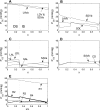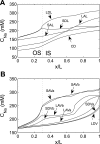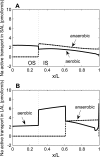A mathematical model of O2 transport in the rat outer medulla. I. Model formulation and baseline results
- PMID: 19403646
- PMCID: PMC2724254
- DOI: 10.1152/ajprenal.90496.2008
A mathematical model of O2 transport in the rat outer medulla. I. Model formulation and baseline results
Abstract
The mammalian kidney is particularly vulnerable to hypoperfusion, because the O(2) supply to the renal medulla barely exceeds its O(2) requirements. In this study, we examined the impact of the complex structural organization of the rat outer medulla (OM) on O(2) distribution. We extended the region-based mathematical model of the rat OM developed by Layton and Layton (Am J Physiol Renal Physiol 289: F1346-F1366, 2005) to incorporate the transport of RBCs, Hb, and O(2). We considered basal cellular O(2) consumption and O(2) consumption for active transport of NaCl across medullary thick ascending limb epithelia. Our model predicts that the structural organization of the OM results in significant Po(2) gradients in the axial and radial directions. The segregation of descending vasa recta, the main supply of O(2), at the center and immediate periphery of the vascular bundles gives rise to large radial differences in Po(2) between regions, limits O(2) reabsorption from long descending vasa recta, and helps preserve O(2) delivery to the inner medulla. Under baseline conditions, significantly more O(2) is transferred radially between regions by capillary flow, i.e., advection, than by diffusion. In agreement with experimental observations, our results suggest that 79% of the O(2) supplied to the medulla is consumed in the OM and that medullary thick ascending limbs operate on the brink of hypoxia.
Figures








References
-
- Adair GS The hemoglobin system. VI. The oxygen dissociation curve of hemoglobin. J Biol Chem 63: 529–545, 1925.
-
- Baxley P, Hellums J. A simple model for simulation of oxygen transport in the microcirculation. Ann Biomed Eng 11: 401–416, 1983. - PubMed
-
- Brezis M, Dinour D, Greenfeld Z, Rosen S. Susceptibility of Henle's loop to hypoxic and toxic insults. Adv Nephrol Necker Hosp 20: 41–56, 1991. - PubMed
-
- Brezis M, Heyman SN, Epstein FH. Determinants of intrarenal oxygenation. II. Hemodynamic effects. Am J Physiol Renal Fluid Electrolyte Physiol 267: F1063–F1068, 1994. - PubMed
-
- Brezis M, Rosen S, Silva P, Epstein F. Renal ischemia: a new perspective. Kidney Int 26: 375–383, 1984. - PubMed
Publication types
MeSH terms
Substances
Grants and funding
LinkOut - more resources
Full Text Sources

